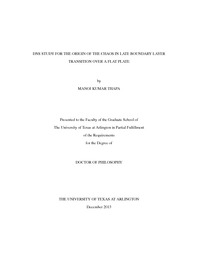
ATTENTION: The works hosted here are being migrated to a new repository that will consolidate resources, improve discoverability, and better show UTA's research impact on the global community. We will update authors as the migration progresses. Please see MavMatrix for more information.
Show simple item record
| dc.contributor.author | Thapa, Manoj Kumar | en_US |
| dc.date.accessioned | 2014-03-12T23:51:59Z | |
| dc.date.available | 2014-03-12T23:51:59Z | |
| dc.date.issued | 2014-03-12 | |
| dc.date.submitted | January 2013 | en_US |
| dc.identifier.other | DISS-12500 | en_US |
| dc.identifier.uri | http://hdl.handle.net/10106/24144 | |
| dc.description.abstract | This dissertation is devoted to the investigation of the origin and mechanism of chaos ( asymmetric or disorganized flow) in late boundary layer transition over a flat plate without pressure gradient. This kind of flow not only exists at the very late stage of transition but also is a crucial component for turbulence formation- still not well understood. According to existing theories, the formation of the chaos in late boundary layer transition was considered due to big background disturbances (noises) and use of non-periodic spanwise boundary condition during numerical simulations. It was further assumed that universal coherent structures (ring-like vortices) are first affected by background disturbances, and then the change in the coherent structures quickly affect the small length scale voritces, which directly leads to flow chaos and eventually the laminar flow changes into turbulence. However, after contemplating our high-order Direct Numerical Simulation (DNS) results, we strongly believe that the internal instability of multiple-level ring cycles triggered by overlapping of those cycles is main reason. Further, We observed, a completely new phenomenon, that the flow chaos process begins at middle part of the structure when the third ring cycle overlaps first and second one. In this work, we also tried trace to as earlier as location for the origination of the chaos atleast for our DNS where certain amplitude of perturbation was introduced only from inlet. A significant asymmetric phenomenon is first noticed from the second cycle at nearly middle of both streamwise and spanwise direction. More technically, a noticeable asymmetric phenomenon in the middle cycle starts at time step t=16.25T and x=838.9 &delta <sub>in </sub> where the top and bottom level rings are still completely symmetric. The disorganized (asymmetric) structure of middle level ring quickly affects the small length scale in boundary layer bottom by primary and secondary “sweeps”. The disorganized process spreads to top level through multiple level “ejections”. In this way, the whole flow domain becomes disorganized in all directions and ultimately the flow state is changed into complex turbulent one. Albeit further research is necessary to complete this work. | en_US |
| dc.description.sponsorship | Liu, Chaoqun | en_US |
| dc.language.iso | en | en_US |
| dc.publisher | Mathematics | en_US |
| dc.title | DNS Study For The Origin Of The Chaos In Late Boundary Layer Transition Over A Flat Plate | en_US |
| dc.type | Ph.D. | en_US |
| dc.contributor.committeeChair | Liu, Chaoqun | en_US |
| dc.degree.department | Mathematics | en_US |
| dc.degree.discipline | Mathematics | en_US |
| dc.degree.grantor | University of Texas at Arlington | en_US |
| dc.degree.level | doctoral | en_US |
| dc.degree.name | Ph.D. | en_US |
Files in this item
- Name:
- Thapa_uta_2502D_12500.pdf
- Size:
- 12.48Mb
- Format:
- PDF
- Name:
- Movie_002.wmv
- Size:
- 16.46Mb
- Format:
- Unknown
- Name:
- tailangle(1).avi
- Size:
- 12.41Mb
- Format:
- video/x-msvideo
This item appears in the following Collection(s)
Show simple item record


